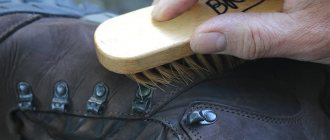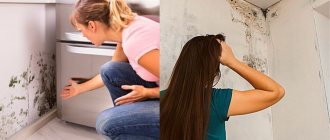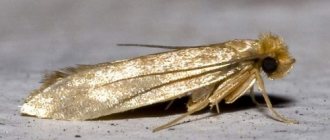Mold is a consequence of impaired air exchange and high humidity. The appearance of spores in the closet can be caused by improper placement of furniture. For example, it is not recommended to place a wardrobe near the bathroom or in a corner.
Other reasons for the appearance of fungus may be:
- clothes not washed with antiperspirants,
- poorly dried things,
- special chemical composition of fabrics,
- poor quality furniture material.
You can get rid of mold forever only after eliminating the factors, otherwise it is useless to remove the fungus; after a while, the spores will appear again.
Causes of bad odor
Before you start fighting mold, it would be a good idea to first understand the reasons for the bad smell in your clothes closet:
- The appearance of fungus can be caused by poor-quality materials from which the cabinet is made: dangerous spores may initially live in the wood;
- Storing wet linen or poorly washed fabrics that emit a stale odor in a closet;
- An increased level of humidity in a room leads to the appearance of mold in furniture, especially if it is made of natural wood;
- Mold can also appear if the furniture is positioned incorrectly: in an angular position, the risk of dampness in the wardrobe increases;
- Sometimes mold can be caused by clothes already contaminated with spores in the closet;
- Close location of the cabinet to the kitchen or bathroom;
- Rare ventilation and washing of the wardrobe followed by drying can also cause mold.
In addition to the reasons described, tissues with a special chemical composition can also be a source of infection.
What can cause an unpleasant odor?
Foreign odor may appear for various reasons. The main one is mold. In conditions of high humidity and stable temperature, mold microorganisms actively multiply, and in a closed chest of drawers, their metabolic products quickly begin to give off a characteristic odor that is difficult to get rid of.
Causes of mold:
- Placing insufficiently dried clothes in the closet;
- Formation of excess humidity inside due to the presence of dampness in the room.
Wood absorbs moisture (and odors) well, creating comfortable conditions for mold. Getting rid of it is the first priority.
Another unpleasant smell found in old chests of drawers is mothballs. Previously, balls containing this substance were used against moths, but their persistent odor can persist for decades.
The ability of wood to absorb causes the presence of odor in almost any antique furniture, unless special measures have been taken to get rid of it. An old musty smell is formed by a complex mixture of aromas that have ever been in a given piece of furniture.
Finally, the presence of smokers or active athletes in the house are two more reasons for the appearance of an unpleasant odor.
Furniture processing
Carry out the treatment only after the closet is completely empty of clothes. Today, there are several simple methods that can at the same time kill harmful spores and save wood from further damage. Let’s look at the 2 most effective ones.
The most common method is to treat wood with soda solution. This method is suitable even for a cabinet with children's underwear, as it is safe. Dissolve 3 tbsp in a liter of water. l. soda, then wash the inside of the cabinet with the resulting solution, including all sides, shelves, walls and doors. Leave the cabinet open for 4 days. You can also use hydrogen peroxide. Treating children's cabinets with peroxide is as safe as using soda.
See also: How to deal with fungus and mold on walls?
Another effective method is chlorine bleach. But keep in mind that this method of dealing with the problem is not suitable for everyone, since chlorine causes an allergic reaction in many people. The method is suitable for processing a closet where the clothes of adult family members are stored. Carrying out such treatment is unacceptable for disinfecting children's furniture.
First, you should remove all clothes from the closet and dry the inner surface using a special dryer or fan, and only then proceed directly to disinfection. It is better to take the wardrobe out of the room into the open air so as not to breathe in harmful fumes.
Mix equal parts water and chlorine bleach, put on gloves and use the resulting solution to wipe all the walls and shelves of the cabinet, inside and out. When done, wash the cabinet with clean water. It is advisable for the wardrobe to stand for about 3 days in the fresh air, which will help eliminate the unpleasant smell of chlorine.
When processing wardrobes using this method, you do not need to add additional detergents to the water so as not to harm your health. Using bleach allows you to completely clean the surface, which ordinary soda, which is best used at the initial stage of infection, cannot cope with.
Preventive measures
Everyone will agree that it is better to prevent the problem than after a while to rack your brains over how to deal with mold in the closet and on clothes. To do this, the following preventive measures must be carried out periodically:
- at least once a month, open the doors and pull out the cabinet drawers to ventilate them;
- Always store clean clothes separately from those you use;
- If the washed laundry is not completely dried outside, dry it in a room before putting it in the closet;
- if you iron washed clothes, give them time to cool while they are laid out;
- Dry the damp jacket or coat you came in from outside in first and only then put it in the closet.
By following all preventive measures, you can be completely sure that your closet and the clothes in it will not be infected with fungus and mold.
How to get rid of mold in a closet?
Not everyone is comfortable emptying a closet completely for a long time in order to wash it.
This is especially true for people who have nowhere else to put their things.
Then other useful recommendations on how to get rid of dampness in a closet with clothes will come to the rescue.
- Immediately sort through the fabrics and inspect them for mold. Wash contaminated items immediately, iron everything else with a warm iron or, if possible, ventilate in the fresh air;
- To get rid of mold, it is often enough to simply move the wardrobe to another location. The sunny side of the room is perfect for this - sunlight on the cabinet walls will lead to the death of spores and quickly eliminate excess moisture;
- Temporarily keep the cabinet open to allow maximum fresh air into it - this will help eliminate dampness;
- Organize your outfits so that items you don't wear are stored in separate, sealed bags. The remaining things need to be laid out more freely so that they do not crowd together. Pay special attention to products made from genuine leather and fur.
- To get rid of fungus in the closet, modern store-bought sprays are suitable. But they will only be effective if you wash the contaminated cabinet walls in advance and ventilate the wardrobe, since they often only provide a flavoring effect.
See also Removing mold from walls in an apartment
It is impossible to get rid of harmful spores in a clothes closet without taking things out. Therefore, try not to let the situation get worse and inspect the wardrobe in a timely manner.
Mold prevention
Of course, after removing mold with various preparations, it is necessary to carry out preventive actions:
The inner surface of the wardrobe walls must be coated with waterproof varnish. The room where the furniture is located must be constantly ventilated. The more ultraviolet (sun) rays entering the room, the better. The plywood sheet covering the back needs to be replaced. To create additional ventilation, you need to drill several small holes at the bottom of the wardrobe. For good ventilation, cabinet doors must be kept open regularly. Dirty laundry should be kept far from clean clothes.
Reference! The above preventive measures can be made more effective. To get rid of an unpleasant odor, just install an aromatic sachet.
Many diseases are associated with the appearance of mold in the room. To prevent this from happening, you need to constantly monitor the furniture and check its condition. If you regularly carry out wet cleaning and use various disinfectants, you can minimize the likelihood of harmful mold appearing.
Furniture Wardrobe
How to remove mold from clothes?
It's much worse when mold appears on the fabric. The chance of returning the fabric to its original normal appearance and removing the unpleasant odor depends on its type, the intensity of the damage and the methods used to combat mold.
- Table vinegar helps get rid of mold in the form of stains and odors on fabric. It should be added in a small amount to the drum of the washing machine and spin the clothes there for a couple of cycles. For best results, it is recommended to pre-soak light-colored fabric in vinegar water (about 5 tablespoons of vinegar per liter of water), then wash and rinse thoroughly. This method helps get rid of both stains and unpleasant odors;
- You can remove stains and unpleasant odors from pure white fabrics without a pattern using bleach or bleach. But if we are talking about synthetics, it is not recommended to use this product, since the fabric may acquire a yellowish tint;
- It is quite possible to get rid of mold and odor on silk and wool with the help of turpentine. To do this, simply soak a cloth in it and wipe the affected areas, then wash and dry thoroughly;
- Linen and cotton linen are best disinfected in hot water with the addition of laundry soap and soda, as other substances can damage the fabric;
- If we are talking about colored fabrics, then you should work especially carefully: the design may fade, and then there will be no point in removing mold stains. Try the product in advance on a small area of the fabric from the inside - if the pattern does not deteriorate, you can safely use the product. Ammonia, which should be diluted in equal proportions with hot water, has worked well in this case. The resulting solution is used to wipe the affected areas;
- A product based on water and oxygen bleach will remove stains and odors from white synthetic laundry. Pour bleach into boiled hot water and soak the fabric in it for an hour, stirring lightly. After this time, rinse the clothes.
There are also cases when mold has become so deeply embedded in the fabric that nothing can be done to remove it. Then all that remains is to say goodbye to such a thing without hesitation.
The appearance of fungal spores in the closet with clothes is easier to prevent than to deal with the problem later. Therefore, ventilate the furniture more often, sort out the things in it and make sure that the wood is not damp!
See also: Removing mold under linoleum using folk remedies
How to eliminate fungus?
If mold is discovered, you need to urgently take measures to get rid of it, otherwise it will very quickly spread throughout all things and then it will simply be impossible to do anything about it and restore the damaged things. If the fungus appears on the walls of the closet, then it has definitely settled in the clothes.
In this case, you need to act like this:
- First, take all your clothes out to the balcony and hang them in the sun, turning them inside out so they don’t fade.
- Then treat the cabinet, namely, remove all plaque so that the problem does not return again.
- Once the items have dried a little in the sun, wash them using a special product that can remove the odor.
- Then dry them, iron them and you can put them back on the shelves.
What to do to prevent mold from appearing on clothes
Special moisture absorbers will help keep clothes in the closet.
Undoubtedly, when people see traces of mold on their clothes, they think about how to get rid of them. However, it is much easier to prevent them from occurring than to search for removal methods and clean out the entire cabinet.
The following measures can be noted to prevent the occurrence of fungus on things:
- To prevent fungi from growing on clothes, you should not put them in a closet while wet;
- any washed item should be sent to dry immediately so that humidity does not contribute to the formation of mold on it and other things;
- if mold has formed in a wardrobe, you need to wash it as soon as possible and thoroughly ventilate all things;
- in order to prevent trouble from occurring, you need to monitor the level of moisture in the rooms; this requires regular ventilation and heating of the room with special devices;
- It would be a good idea to place special moisture absorbers on the shelves of your wardrobe.
In order not to think about how to remove mold stains, you should treat things with special attention, wash and air them in a timely manner. Don’t forget about the microclimate of the room, the level of moisture in which determines the likelihood of fungus occurring.
Criteria for the selection and use of funds
When choosing a means to destroy mold on clothes, you need to consider:
- Fabric type.
- The color of the item.
- Degree of infection.
- Processing method.
Cost also plays an important role.
Important! When choosing such products, be sure to familiarize yourself in detail with their composition, warnings and limitations, and instructions for use.
Mold does not like high temperatures and chemicals. Fabrics are also quite demanding in terms of methods and means of influencing them:
Linen and cotton clothes in white or pastel shades can be safely boiled with the addition of chlorine-containing chemical products.- Wool and synthetic fabrics react negatively to high temperatures, as this destroys their structure. Stain removers are used to clean them from mold.
- silk items from mold using turpentine or ammonia. Stain removers may harm delicate fabrics.
- Leather clothing is not afraid of mechanical stress, but is sensitive to chemicals, so it is better to remove mold from it with a stiff brush and soap solution.
- Bright items may lose their color when exposed to chemical reagents, so before use you should carefully study the rules for using the product and conduct a spot test of the fabric reaction on the wrong side of the clothing.
- Fabrics that are slightly contaminated with fungus can be saved by using regular laundry detergent, but stain removers and bleaches will have to deal with a harmful substance that is firmly ingrained into the structure of the material.
Harm to furniture, clothing and linen
Infected furniture smells unpleasantly damp. Over time, all wooden surfaces can become deformed, rot and fall apart. It’s good that this rarely happens, since it’s difficult not to notice the unpleasant smell and black, green, white mold spots on furniture for a long time.
Make sure that mold does not appear in the washing machine
Damage is also caused to the clothing inside:
- Spores from contaminated clothing can get into the washing machine, from there onto other things, and through them spread throughout the home.
- Things smell bad. Moreover, this causes not only discomfort. If there are a lot of spores in the tissue, then when they are inhaled, a person begins to sneeze.











